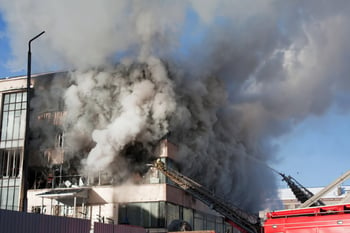 Smoke control systems are an invaluable and crucial part of a building’s fire safety systems that work in conjunction with a range of other components to keep buildings and people safe in the event of a fire.
Smoke control systems are an invaluable and crucial part of a building’s fire safety systems that work in conjunction with a range of other components to keep buildings and people safe in the event of a fire.
One way in which they do this is by allowing firefighters more control in keeping escape routes and common areas free of smoke. This not only gives them more time to search for and evacuate people safely, but also helps to contain the smoke to the floor or area where the fire broke out, meaning they can reach it much faster. Containing smoke to one specific area in the building also means the overall damage can be minimised.
By default, smoke control systems will be activated automatically by a smoke detector and will either open AOVs (if it is a natural system) or will activate mechanical fans to either start extracting smoke or, if a pressure differential system is used, pumping fresh air in to keep smoke away from occupants. This usually happens before the firefighting team has arrived on the scene to allow people to start evacuating the building immediately. However, frequently, when firefighters arrive at the scene, it is beneficial to them to be able to control the behaviour of the system in certain areas of the building to adjust the performance to suit their firefighting strategy. For instance, depending on the situation, they might choose to open or close stairwell ventilators at either the top or bottom or a staircase. Likewise, with pressure differential systems, they may want to increase the speed of the fans from their initial “means of escape” setting to a higher firefighting speed.
 If a firefighting team decides that manual control of the system is necessary, they will do this using a control panel or manual override switch that is connected to different sections or components of the smoke control system. While these controls are obviously very beneficial to firefighters, they have also been known to cause issues due to the non-standard way in which they are produced and installed. For instance, different smoke control companies have different control panel designs and interfaces. The frequency and different scenarios that firefighters encounter these control systems in, means it is impossible for them to be familiar with the precise operating instructions of each one. The position where these controls are installed in a building can also vary, meaning firefighters can end up wasting time trying to locate the controls. Even worse, if they are not familiar with the way a control panel operates, they could inadvertently enable or disable a part of the system they did not mean to, causing the system to become ineffective. Therefore, it has been argued that smoke control systems should be designed to operate automatically in firefighting mode without the need for manual intervention by firefighters or the general public.
If a firefighting team decides that manual control of the system is necessary, they will do this using a control panel or manual override switch that is connected to different sections or components of the smoke control system. While these controls are obviously very beneficial to firefighters, they have also been known to cause issues due to the non-standard way in which they are produced and installed. For instance, different smoke control companies have different control panel designs and interfaces. The frequency and different scenarios that firefighters encounter these control systems in, means it is impossible for them to be familiar with the precise operating instructions of each one. The position where these controls are installed in a building can also vary, meaning firefighters can end up wasting time trying to locate the controls. Even worse, if they are not familiar with the way a control panel operates, they could inadvertently enable or disable a part of the system they did not mean to, causing the system to become ineffective. Therefore, it has been argued that smoke control systems should be designed to operate automatically in firefighting mode without the need for manual intervention by firefighters or the general public.
Expert smoke control systems from the UK’s most trusted supplier
As the UK’s longest-standing and leading smoke control provider, Colt systems have been installed in more buildings than anyone else’s since the 1950’s. During this time, we have had the opportunity to work with and learn from firefighters about ways in which we can refine the design and operation of our systems to support them in the best possible way - our systems and controls panels are well respected within the industry.
If you would like more information about how a Colt system or its controls will operate in and support a fire crew in the event of a fire, get in touch.
 Conor Logan is Associate Technical Director of Colt UK, Smoke and Climate Control Division. Conor designs innovative smoke control and HVAC systems and was Chairman of the Smoke Control Association for over 9 years.
Conor Logan is Associate Technical Director of Colt UK, Smoke and Climate Control Division. Conor designs innovative smoke control and HVAC systems and was Chairman of the Smoke Control Association for over 9 years.


